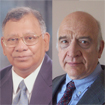
Dr. K. L. Mittal, Dr. Robert H. Lacombe
The last two issues of the SURFACE SCIENCE CORNER BLOG dealt with polymer surface modification through plasma processing. One of the main issues dealt with the problem of controlling the resulting surface properties created by the highly aggressive nature of the plasma environment. The large number of chemically active species in the plasma can give rise to unwanted surface chemistries unless special steps are taken to avoid this problem. The use of monosort functionalization and pulsed plasmas as discussed by Prof. Jeorge Friedrich in the previous issue of this blog are two possible ways of approaching this problem. However, the question still remains as to what changes in the surface were actually made after processing? This question brings us to the topic of surface characterization and in particular the use of contact angle measurements to conveniently and rapidly assess the wettability characteristics of a given surface.
In this regard, those who would have an interest in following the latest developments in the overall field of contact angle measurements and wetting behavior will definitely want to mark their calendars for the upcoming symposium:
TENTH INTERNATIONAL SYMPOSIUM ON CONTACT ANGLE, WETTABILITY AND ADHESION; to be held at the Stevens Institute of Technology, Hoboken, New Jersey, July 13-15, 2016.
Researchers from universities, technical institutes and industrial labs the world over will be presenting some of their latest work on this rapidly expanding technology which is finding applications in a wide range of cutting edge innovations including: self cleaning surfaces, nano and micro fluidics, microbial antifouling coatings, superhydrophobic and superoleophobic surfaces and electrowetting to name just a few of the more active research areas. Interested readers can follow the development of this meeting at the following web site:
www.mstconf.com/Contact10.htm
By way of an introduction to the topic of contact angle behavior, the remainder of this note will present some highlights of work presented at a previous meeting in the contact angle series held at Laval University in 2008. The rudiments of the contact angle experiment were covered in the July 2014 issue of this blog. The following discussion will cover some of the more current topics that were covered at the 2008 meeting in Laval.
Superhydrophobic/hydrophilic Behavior
The topic of superhydrophobic/superhydrophilic behavior was under very active investigation by many research groups worldwide as illustrated by the 9 papers submitted to the symposium. Applications range from self cleaning surfaces to preventing ice buildup on power lines. A most interesting paper was presented by Dr. Picraux from the Los Alamos National Laboratory entitled “Design of Nanowire Surfaces with Photo-induced Superhydrophilic to Superhydrophobic Switching”. The authors claim that they have developed functionalized photochromic monolayers for which the wetting angle of liquids can be reversibly switched optically by more than 100 degrees between superhydrophilic and superhydrophobic states. One would imagine that there would be tremendous applications for this technology in the realm of hand held tablets which are so tremendously popular these days.
Behavior of Water and Ice
During the week of January 5-10, 1998 a severe ice storm ravaged Southeastern Canada. The total water equivalent of precipitation, comprising mostly freezing rain and ice pellets and a bit of snow, exceeded 85 mm in Ottawa, 73 mm in Kingston, 108 in Cornwall and 100 mm in Montreal. Further details of this horrific storm have been covered in the MST CONFERENCES newsletter and may be accessed at (www.mstconf.com/Vol5No1-2008.pdf). The prolonged freezing rain brought down millions of trees, 120,000 km of power lines and telephone cables, 130 major transmission towers each worth $100,000 and about 30,000 wooden utility poles costing $3000 each. Consequences for the local population were predictably disastrous with about 900,000 households without power in Quebec; 100,000 in Ontario. It is of little surprise then that the surface interactions of freezing water and aluminum power cables is of considerable interest to the Canadian government and of little surprise also that contact angle measurements are playing a significant role in the effort to understand and control these interactions. Thus no fewer than 4 papers were dedicated to this problem.
Novel Applications
It seems that hardly a day goes by but some new application of the contact angle behavior of surfaces arises apparently from nowhere. In fact, Carl Clegg of the ramé-hart instrument company has listed 50 different uses of the contact angle method ranging from the authentication of rare coins to the improved biocompatibility of polymer-based medical devices. For details see:
(www.ramehart.com/newsletters/2010-12_news.htm).
Adding to this there was a most interesting paper by Dr. Daryl Williams entitled “The Surface Energy of Pharmaceutical Solids- Its Importance in Solids Processing” which now adds pharmaceutical processing to the already extensive list. Undoubtedly even more unsuspected applications will surface in the future.
Oil Recovery and Mining Applications
The world’s insatiable thirst for fossil fuel products has lead to the quest to recover oil from progressively less productive sources such as tar sands and heretofore depleted wells. A moments reflection makes it clear that surface interactions between the residual oil and the surrounding rock are what dominates the problem of separating the oil from the rock. Again contact angle measurements are one of the leading methods being used to understand this problem.
Contact Angle in Micro and Nano Technology
The contact angle method is making remarkable inroads into the field of micro and nano technology mainly through the advent of micro-fluidics and micro-patterning of surfaces to control their wetting behavior. In the past I was always amazed at the very significant interest of Mechanical Engineering departments in the contact angle method. Being of the old school I always associated mechanical engineering with roads, bridges, automobiles, aircraft … etc. A moments reflection, however, quickly reveals that fluid flow is also an important mechanical engineering problem and that this problem is beginning to shift toward the micro-fluidics problem of flow in very small channels a micron or less in diameter. At this scale gravity is all but irrelevant and it is surface forces, governed by van der Waals interactions, that dominate. Again the contact angle technique is one of the most useful tools in investigating this behavior. Added to this the extensive efforts now underway in patterning surfaces to control their wetting behavior is bringing the contact angle method to the forefront in the realm of micro and nano technology. The paper presented by Dr. Mikael Järn of the YKI, Institute for Surfaces entitled “Wettability Studies of Selectively Functionalized Nanopatterned Surfaces” is a prime example of this new and exciting development in surface science.
Applications to Wood Science and Technology
Wood and wood products have been a mainstay of mankind since even before the dawn of civilization. Needless to say wood and wood products are still very much with us due to their ubiquity, unique properties and general availability as a relatively cheap and renewable resource. What is perhaps not so obvious is the many new and varied applications that wood is being put to by varying its surface properties through the use of plasma modification. Not surprisingly the contact angle method again comes into the picture in order to characterize the new surface properties. The paper of Dr. B. Riedl of Université Laval entitled “Influence of Atmospheric Pressure Plasma on North-American Wood Surfaces”, highlights this trend nicely.
We can be sure that the above mentioned topics and many more will be the presented and discussed at the upcoming 10th in the contact angle symposium series to be held next year. Anyone with further interest should feel free to contact me at the address below.
Dr. Robert H. Lacombe, Chairman
Materials Science and Technology CONFERENCES
Hopewell Junction, NY 12533-6124, E-mail: rhlacombe@compuserve.com
Recommend- Hello Khoren, Just read your editorial. I have an immediate need for a medical device application....
- Good analysis. I’m glad you mentioned that the velocity with which space is traversed has not appreciably...
- I really like your writing style, superb information, thankyou for putting up : D.
- Great blog article.Really thank you! Really Cool.
- Very Interested. Are you represented in Australia? What is the cost of the unit? How do you retrofit?...







Write a comment